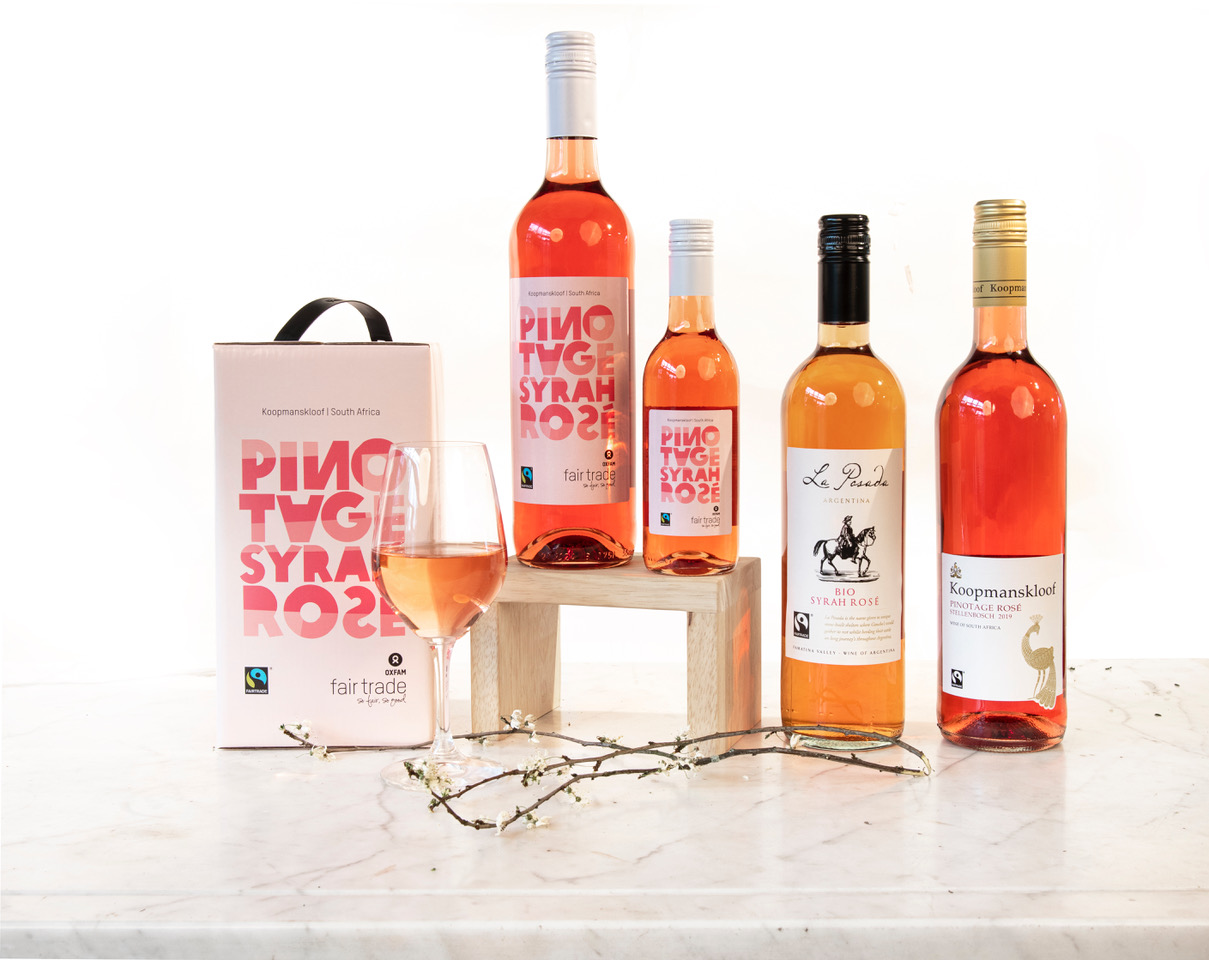
How is Oxfam’s rosé made?
Rosé might be one of the most underappreciated categories in the assortment. Rarely does this wine get the attention it deserves. Captivating, rewarding and versatile, it’s perfect as an aperitif or paired with a meal. But how are tasty rosés such as ours made? Oxfam rosé is made through a …
Rosé might be one of the most underappreciated categories in the assortment. Rarely does this wine get the attention it deserves. Captivating, rewarding and versatile, it’s perfect as an aperitif or paired with a meal. But how are tasty rosés such as ours made?
Oxfam rosé is made through a combination of the processes for making red and white wine.
- As with red wine, the fermentation process is started using the skins to impart their colour and flavours. For rosé, this so-called maceration process is stopped after just 48 hours, instead of the usual 2 or 3 weeks for red wine.
- The next step is pressing the wine.
- The wine then ferments further at a chilled temperature, as with white wine. This retains the freshness.
- When the fermentation and resting period are complete, the wine is stabilised, filtered and bottled.
Another method of making rosé is to ‘blend’ red and white wine. Oxfam Fair Trade’s non-sparkling rosé wines from Argentina and South Africa are never ‘blended’, however. In fact, in Europe the only wines permitted to be ‘blended’ are sparkling wines and champagnes. That’s how our Chilean Sensus Brut Rosé is made.
A gamut of colours and flavours
The result of these processes?
- a beautiful rosé colour, lighter or darker depending on the duration of the maceration period and the type of grape used; different sorts of grape contain differing levels of natural pigmentation
- a refreshing wine
- light, fruity flavours
- low tannin content
The crucial challenge for every rosé-winemaker is to seek out the perfect combination of colour and flavour, freshness and fruitiness.
Facts about Oxfam’s rosé wines
- All Oxfam’s rosé wines are 100% fair trade and 100% vegan (with the exception of the organic Argentinian Syrah).
- We offer a varied assortment in the formats 25 cl, 75 cl and 3 l bag-in-box.
- Rosé wines have a short shelf life and should be consumed while they’re still young, ideally within two years of their vintage. As such, this type of wine is not suitable for ageing.
- All of Oxfam’s rosé wines are dry, with a low residual sugar content (< 5 g/l). In other words: we don’t have any sweet rosés. Our sparkling rosé wine has the highest residual sugar content of all our rosés, although this is still well within the norm of < 15 g/l for a brut sparkling wine.
Diverse origins, diverse flavours
The variety, ripeness, and concentration of the grape also influence the flavour. For example, the ripeness of the grape determines the sweetness: the riper the grape, the sweeter the wine.
South-African grapes and blends
The Pinotage grape is a popular South-African grape that we made sure to include in our range of rosés. This grape is not so highly pigmented in itself. It is actually a cross between the Pinot Noir and Cinsault grapes. The Pinotage grape offers generous flavours of red fruit, such as redcurrant, and has a distinctly smoky character. These flavours are most prominent in the red wine produced from it but can also be detected in the finish of its rosés. The ideal accompaniment to a summer BBQ!
- The Koopmanskloof Pinotage rosé is bursting with flavour thanks to the lower tonnage of grapes harvested per hectare. This increases the concentration of the grape and thus the wine. This wine is bottled at the bottling facility near Stellenbosch.
- Our Shiraz-Pinotage is, as the name suggests, a blend of two grape varieties. The fruity and subtly smoky Pinotage is boosted in colour and complemented in flavour by the Shiraz, with its fruity and spicy notes. This wine is somewhat lower in concentration and is shipped to Belgium in bulk containers. It is then bottled here in Belgium. This enables us to offer a somewhat more inexpensive rosé that, needless to say, still boasts an excellent price-quality ratio. This wine is available in 25 cl and 75 cl bottles or a 3 l bag-in-box.
Argentinian powerhouse
Our Argentinian partner La Riojana has in recent years come to specialise in organic wines. In addition to their red and white organic wines, we also offer their excellent organic rosé: the BIO La Posada Syrah rosé. This is a fuller-bodied rosé, very much suitable for drinking with a meal. Naturally, this wine meets all the organic production criteria, in both the vineyard and the winery.
Sparkling rosé from Chile
On the other side of the Andes, in Chile’s Elqui Valley, the cooperative CAPEL makes our Sensus Brut sparkling rosé. The non-sparkling wine on which this delightful sparkling rosé is based is a mix of white wine produced from Pedro Jimenez grapes and 1% red wine made from Cabernet and/or Carmenère grapes. This blend of red and white wine then goes into the Charmat tank by the 10,000 litres (approx.) for a second fermentation. After a month in the vat the sparkling wine is bottled under constant pressure and shipped by boat to the Oxfam Fair Trade Logistics depot.
Looking to purchase some wine?
- Discover our assortment of rosés.
- Still devoted to red or white? View our full range.
- Looking for a particular grape or region? Or for only vegan or organic wines? Consult the Oxfam wine assistant app (Dutch only).
- For a tailored quote, contact our wine team. They’ll be more than happy to help you pick out the perfect wine(s) for your needs.


